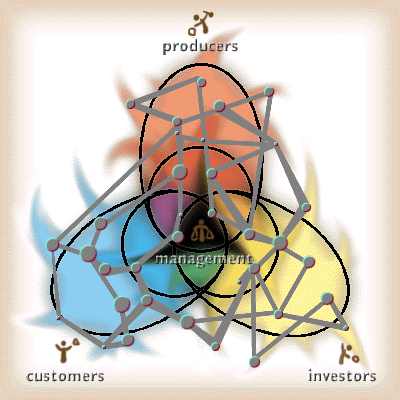ValueWeb
Communities

Making
the Wealth Creation Engine
|
|
I
believe that the ValueWeb concept
will be the next
organizing principle of business, governments,
NGOs and other communities of practice and interest.
Present organizational models and practices fail
to meet the conditions of the modern workplace and
markets.
|
|
These
traditionally separated forms of enterprise (government
and and private; profit and nonprofit; institution
and community) will be more closely structured
in three principle ways. First off, they will tend
to operate more in the same way. More importantly,
they will intertwine with each other to a far greater
extent that we have seen (in the West) in the last
couple of centuries. Third, almost no matter their
location or size, they will most likely be part
of global webs in some way - and, as nodes in those
webs, they will be connected to many cooperating
and competing organizations and networks. Nodes
within them will be nodes in other webs. This complexity
will require that ValueWebs and their components
(networks, nodes, channels, clusters) operate by
Patchworks-like
rules. ValueWebs are best understood a Living Systems
(Miller).
|
|
The
ValueWeb Model is made up of four
major components - each in themselves a network
which can be a ValueWeb architecture on anther level
of recursion. They are: the user (customer)
network; the producer network (including
supply chain); the investor network (including
social investors) - and, the system integrator
(management). No matter the size of a ValueWeb,
these four components have to be in relative balance
with one another else the web will be distorted
and start acting in strange and unstable ways. The
Networks themselves and made up of sectors (we call
them “clamshells”) each with it’s
own unique function. In all, there are 22 distinct
types of components and sub-components that make
up a mature ValueWeb. Each will “play”
differently in any particular ValueWeb. Nevertheless,
understanding the basic nature of these components
is all that is required to start discovering how
ValueWebs work and to engage in the design process
of making one.
|
|
The
purpose of a ValueWeb is to create and distribute
wealth. Wealth in the broadest definition not just
in narrow (UpSideDown)
economic terms. And, the idea of equable distribution
is to do it in the terms of each individual
ValueWeb member. This is something a generic economy
does not do to the level of fine graininess required
by today’s circumstances. People become stakeholders
of an enterprise for different reasons. An investor,
for example, who is investing for long term revenue
is different that one investing for rapid growth.
A knowledge-worker looking for experience is different
than one supporting a mature family with children
in collage. Customers, also, can have different
reasons for buying the same product. These interests
can be come unnecessarily competitive. Their conflict
can distort the enterprise’s efforts creating
destructive long term liabilities. Sometimes financial
markets cause a company to make decisions for short
term results that they know are unwise in the larger
scheme of things. This is but one example. Markets
as a whole sort these kinds of issues out. Enterprises
need to be able to do the same inside their own
domain. Policy has to give way to internal markets
and organic adaptation. In a ValueWeb architecture,
the mechanisms exist that support all stakeholders
in this process.
|
|
The
definition of WEALTH is shifting. This is
being driven by many trends. The amount of wealth,
itself is a factor. Notice in the 2001-2002 turndown,
despite layoffs and September 11, consumers continued
to spend. This shortened the recession a great deal.
The wealth creation in the last two decade has been
tremendous. Despite theoretical loses when stock
markets retreat, there remains great stockpiles
of cash and credit. Where governments used to intervene
to charge the economy, people now do it themselves.
|
|
Wealth
creation tools are much more ubiquitous. 25 years
ago if one want to do work requiring great computing
power s/he had to work for the government, military,
a university or large corporation. No more. Tremendous
capability is available virtually everyone in the
advanced countries. Shared computing over the Internet
has accomplished tasks that used to take super-computers
with large supporting organizations. This is a knowledge
economy now and the tools necessary for knowledge
creation are widely available and rapidly becoming
more so.
|
|
The
amount of available capital and the sophistication
of investment channels is changing the landscape
of business and NGO start ups. Incubators are progressively
learning how to facilitate this process. This is
not unlike the development of the great industrial
research institutions of the 20th century. These
feed a steady supply of basic knowledge and applications
ideas into large corporations. WWII and the Cold
War stimulated tremendous R&D which added to
the flood of new products in the 90s. These processes
of “enterprise-making” are now widely
distributed - however, they are not integrated.
The refocusng of corporations to their markets,
the decline of defence related R&D, the relative
decline of the government, university, business
covenent that emerged from WWII has left and integration
gap.
|
| Great
wealth-creating capacity exists. Greater potential
is still latent, disconnected and sub-optimized. |
|
Matt
Taylor
Palo Alto
March 13, 2001 |

SolutionBox
voice of this document:
INSIGHT • POLICY • PROGRAM
|
posted:
March 13, 2001
revised:
February 17, 2002
• 20010313.233751.mt • 2000324.333329.mt •
20020214.540981.mt •
• 20020217888840.mt •
Copyright©
Matt Taylor 1985, 1996, 2001, 2002
|
|